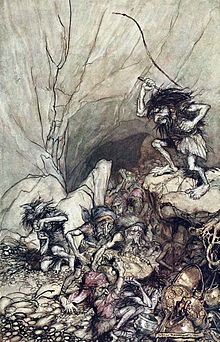
Back Нибелунги Bulgarian Nibelungs Catalan Нибелунгсем CV Nibelungoj Esperanto Nibelungo Spanish Nibelungo Basque Nibelungen French Nibelunghi Italian ნიბელუნგები Georgian 니플룽 Korean
This article has multiple issues. Please help improve it or discuss these issues on the talk page. (Learn how and when to remove these template messages)
|

The term Nibelung (German) or Niflungr (Old Norse) is a personal or clan name with several competing and contradictory uses in Germanic heroic legend. It has an unclear etymology, but is often connected to the root Nebel, meaning mist. The term in its various meanings gives its name to the Middle High German heroic epic the Nibelungenlied.
The most widespread use of Nibelung is used to denote the Burgundian royal house, also known as the Gibichungs (German) or Gjúkingar (Old Norse). A group of royal brothers led by king Gunther or Gunnar, the Gibichungs are responsible for the death of the hero Siegfried or Sigurd and are later destroyed at the court of Attila the Hun (called Etzel in German and Atli in Old Norse). This is the only use of the term attested in the Old Norse legends.
In medieval German, several other uses of the term Nibelung are documented besides the reference to the Gibichungs: it refers to the king and inhabitants of a mythical land inhabited by dwarfs and giants in the first half of the Nibelungenlied, as well as to the father and one of two brothers fighting over a divided inheritance. This land and its inhabitants give their name to the "hoard of the Nibelungs" (Middle High German der Nibelunge hort). In the late medieval Lied vom Hürnen Seyfrid, the name, in the form Nybling or Nibling, is given to a dwarf who again gives his name to the treasure.
In Richard Wagner's opera cycle Der Ring des Nibelungen (1848–1874), Nibelung denotes a dwarf, or perhaps a specific race of dwarfs.
© MMXXIII Rich X Search. We shall prevail. All rights reserved. Rich X Search